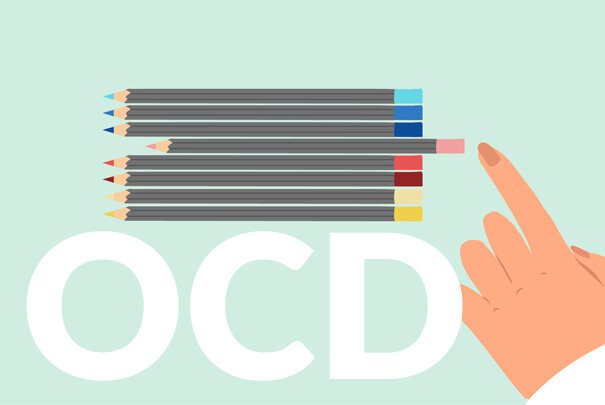What is Obsessive Compulsive Disorder?
Obsessive Compulsive Disorder, commonly referred to as OCD, is a specific type of anxiety disorder.
In addition to involuntary negative thought patterns and overwhelming anxiety, a person suffering from OCD will develop rituals designed to combat those thoughts and anxieties. At the same time, the rituals themselves become a habit or addiction while not offering any real relief from the anxiety or negative thoughts.
Thus, OCD has two primary components:
Obsession: involuntary negative thoughts or feelings that overwhelm and crowd out normal thought patterns
Compulsion: patterns of behavior that develop in response to negative thought patterns that themselves become involuntary and impossible to stop
Of course, everyone develops habits and rituals designed to help them cope with stress and anxiety. For most people, these habits are either a temporary response to a specific situation or a minor irritation that simply becomes a part of their everyday life.
OCD becomes a mental health concern when it undermines the ability to live a normal, healthy lifestyle. Mental health experts will generally diagnose OCD when the obsessions or compulsions begin to occupy an hour or more every day, cause significant distress, and negatively impact relationships and the ability to do the things you want or need to do.
What are the Most Common Types of OCD?
Because OCD can manifest in many different ways, all of which are unique to the individual, there is no official classification system for OCD. Generally speaking, however, mental health experts recognize five types or groupings of OCD, described in broad (and overly simplified) terms as:
Cleaning and Contamination: Characterized by excess worry about getting sick and feeling unclean or unwell. Usually manifests as a fear of germs, chemicals, toxins, stickiness, and even people who appear unwell. Protective rituals involve excessive cleaning and sterilizing, as well as avoiding places and situations associated with germs or uncleanliness, such as public restrooms.
Accidental Harm and Checking: Characterized by intrusive images and fears of accidentally harming oneself or others, often accompanied by excessive feelings of doubt, dread, and uncertainty. Protective rituals involve compulsive “checking” to ensure that preventative action has been taken: for instance, repeatedly going back to check that the stove has been turned off or the door to the house has been locked.
Symmetry and ordering: Sometimes called “just right OCD”, this categorization is characterized by intense perfectionism, or feelings of intense discomfort if things are not arranged or organized in specific ways. Rituals involve repetitive arranging, counting, aligning, spacing, or other “ordering” behaviors, and may, in some patients, involve so-called magical thinking (the belief that something bad will happen if you don’t organize things in the correct way).
Hoarding: Characterized by the persistent worry about the negative consequences of throwing something away and the compulsive need to collect or buy items in a certain number. It can also involve difficulty throwing things away due to fear of touching them and the need to repetitively check on possessions. This OCD differs from hoarding disorder because unlike hoarding disorder, hoarding OCD causes extreme distress.
Forbidden or Taboo Thoughts or Impulses: Characterized by overwhelming and unwanted obsession with taboo thoughts, usually related to religion, sex, or violence. Individuals with this type of OCD typically have no history of violence or deviant behavior and do not usually act on the taboo thoughts. Instead, the obsessive element lies in the amount of time devoted to combatting thoughts they know to be dangerous and immoral. In the past, it was believed that some individuals with this type of OCD should be considered as a sixth sub-type called “Pure-O” or “Pure Obsession” because they do not display overt rituals in response to the obsessive thoughts. Most mental health experts today, however, disagree, noting that although they are not overt, this type of OCD usually involves excessive and significant mental rituals, such as prayer, neutralizing thoughts, mental arguing, etc. that are just as debilitating as visual rituals.
What is the Treatment for OCD?
Because OCD develops and manifests differently in each person, the specific treatment approach will depend heavily on that unique person’s disease and response to different types of treatment options.
In most cases, treatment for OCD involves Cognitive Behavioral Therapy (CBT) or medication, or potentially a combination of the two.
One of the most successful therapy options for many OCD patients is a type of CBT called Exposure and Response Prevention, or ERP. In a safe space, ERP slowly increases exposure to triggers at the root of the OCD, while helping the patient learn how to recognize and reorder patterns of negative thinking as well as experience discomfort without relying on rituals.
For individuals suffering from taboo thought obsessions, another type of CBT called mindfulness-based CBT may be more effective than ERP, since the OCD cannot be “triggered” by exposure to a specific thing or situation.
For some individuals with severe OCD, antidepressants or antipsychotics may help relieve specific symptoms of the OCD or in the short term, give the patient time to learn how to cope with the symptoms through therapy.
Every individual responds differently to different types of medications, however, so each pharmaceutical and therapeutically approach must be carefully tailored to match the needs, symptoms, and responses of each unique patient.
NEED HELP?
Collaborative Therapeutic Services (CTS) wants to help. We offer a variety of counselling and therapy services, hours, and service providers with diverse specializations. We offer evening & weekend appointments in office or by TeleHealth conferencing.
Have questions? Contact Us Here or Call 813-951-7346. Located in Tampa, Florida. Ask us about our new NEUROLEASE™ TREATMENT THERAPY - A cutting edge treatment for releasing toxic emotions.

